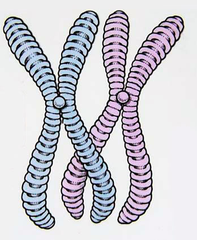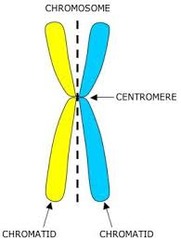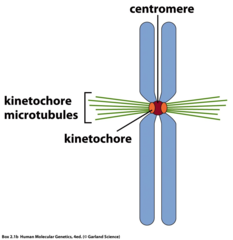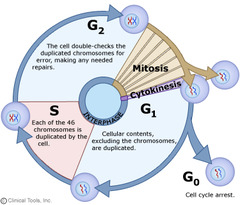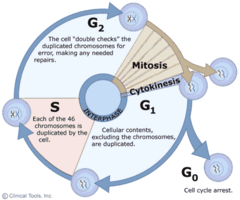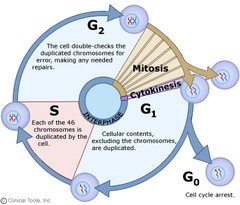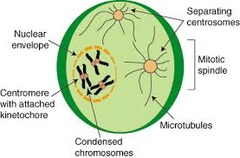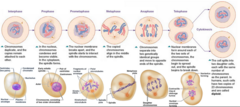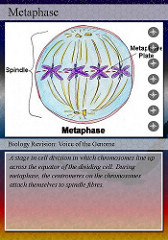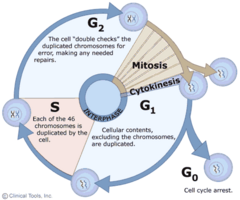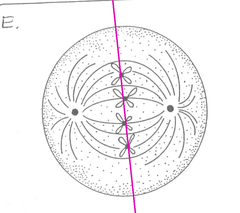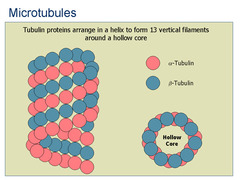Chromosome
Threadlike structure of nucleic acids and protein found in the nucleus of most living cells, carrying genetic information in the form of genes
Sister chromatids
The two identical chromatids formed by the replication of a single chromosome, with both copies joined together by a centromere; one strand of DNA is contained in each chromatid
Centromere
Regions of DNA where the sister chromatids are most tightly connected
Kinetochore
Patch of protein found on the centromere of each sister chromatid
Mitotic spindle (2 points)
1. Consists of fibers made of microtubules and other proteins that begins to form in prophase
2. Includes the centrosomes, the spindle microtubules, and the asters
Binary fission
Type of cell division by which prokaryotes (bacteria and archaea) reproduce
During binary fission of a bacterium, __________.
origins of replication move apart
During _____ both the contents of the nucleus and the cytoplasm are divided
…
During _____ the cell grows and replicates both its organelles and its chromosomes.
…
Which of these phases encompasses all of the stages of mitosis but no other events?
…
Interphase
Large phase of the cell cycle that includes cell growth and copying of chromosomes in preparation for cell division
G₂ phase (4 points)
Phase of interphase
1. Nuclear envelope encloses the nucleus
2. Nucleus contains one or more nuclei
3. Two centrosomes have formed by duplication of a single centrosome
4. Chromosomes duplicated during S phase haven’t condensed yet
Prophase (4 points)
1. Chromatin fibers become more coiled, condense into chromosomes
2. Each duplicated chromosome appears as two sister chromatids joined by centromeres
3. Nucleoli disappears
4. Mitotic spindle composed of centrosomes with microtubules extending from it begins to form, and its centrosomes move away from each other
Prometaphase (late prophase) (5 points)
1. Nuclear envelope fragments so microtubules extending from each centrosome can invade the nucleus area
2. Chromosomes become more condensed
3. Each of the 2 chromatids of each chromosome now has a kinetochore
4. Some microtubules attach to the kinetochores, becoming kinetochore microtubules
5. Nonkinetochore microtubules interact with those from opposite pole of spindle
Metaphase (3 points)
1. Centrosomes now at opposite poles of the cell
2. Chromosomes all have arrived at the metaphase plate, and their centromeres lie there
3. Kinetochores of each chromosome’s sister chromatids are attached to kinetochore microtubules coming from opposite poles
Anaphase (4 points)
1. Begins when cohesin proteins are cleaved, allowing the 2 sister chromatids of each pair to part, so each chromatid becomes a full chromosome
2. Two daughter chromosomes move centromere-first toward opposite ends of the cell as their kinetochore microtubules shorten
3. Cell elongates as the nonkinetochore microtub’s lengthen
4. The two ends of the cell have equivalent collections of chromosomes
Telophase (5 points)
1. Two daughter nuclei form in the cell
2. Nuclear envelopes arise from the fragments of the parent cell’s nuclear envelope and other parts of the endomembrane system
3. Nucleoli reappear
4. Chromosomes become less condensed
5. Any remaining spindle microtubules are depolymerized
Mitosis is now complete
Cytokinesis (2 steps)
1. Division of the cytoplasm is usually underway by late telophase, so two daughter cells appear shortly after end of mitosis
2. In animal cells, cytokinesis involves formation of a cleavage furrow
The mitotic phase
encompasses both mitosis and cytokinesis; phase during which both the contents of the nucleus and the cytoplasm are divided
During _____ the cell grows and replicates both its organelles and its chromosomes.
Interphase
Aster
Radial array of short microtubules extending from each centrosome
Metaphase plate
Imaginary plane midway between the spindle’s two poles that contain the centromeres of all duplicated chromosomes during metaphase
At which end do kinetochore microtubules shorten during anaphase?
…
If a human somatic cell is in metaphase, it has __________ chromatids.
…
What process does not occur in dividing bacteria?
Mitosis
Observations of cancer cells in culture support the hypothesis that cancer cells __________.
do not exhibit density-dependent inhibition
In a human skin cell that is going through the cell cycle, when do the centrosomes separate?
Prophase
During interphase, the genetic material of a typical eukaryotic cell is __________.
dispersed in the nucleus as long strands of chromatin
Somatic cell
Any cell of a living organism other than the reproductive cells
To synthesize one glucose molecule, the CC uses ___ molecules of CO₂, _____ molecules of ATP, and ____ molecules of NADPH.
6 ; 18 ; 12
To synthesize one G3P molecule, the CC uses ___ molecules of CO₂, _____ molecules of ATP, and ____ molecules of NADPH.
…
A biochemist measured the amount of DNA in cells growing in the laboratory and found that the quantity of DNA in the cells doubled __________.
between the G1 and G2 phases
Tissue culture experiments with PDGF demonstrate that without this substance _____.
1) bacterial cells lose their resistance to antibiotics
2) cells divide in an uncontrolled fashion, confirming its role as a cell division inhibitor
3) fibroblasts fail to divide
4) animal cells are unable to attach to the substratum
5) the various kinases, such as MPF, are unable to bind to cyclin
Fibroblasts fail to devide
Walther Flemming
Developed dyes that allowed him to observe the behavior of chromosomes during mitosis and cytokinesis for the first time
Cytokinesis often, but not always, accompanies _____.
telophase
Chromosomes become visible during _____.
Prophase
Centromeres divide and sister chromatids become full-fledged chromosomes during _____.
During anaphase, sister chromatids separate and daughter chromosomes migrate to opposite poles.
Spindle fibers attach to kinetochores during _____.
prometaphase
During prophase a homologous pair of chromosomes consists of _____.
…
…
During anaphase centromeres come apart, and sister chromatids become full-fledged chromosomes, which migrate to opposite poles of the cell.
…
Cytokinesis in animal cells involves the formation of a cleavage furrow.
…
Events of prophase include the condensation of chromatin and the dispersal of nucleoli.
…
The events of prometaphase include the attachment of spindle fibers to kinetochores.
…
Cytokinesis in plant cells involves the formation of a cell plate.
…
During telophase both nuclear envelopes and nucleoli re-form.
During prophase a homologous pair of chromosomes consists of _____
2 chromosomes, 4 chromatids
The cleavage furrow forms during which stage of mitosis and cell division of an animal cell?
Cytokinesis
The person credited with the axiom, “Every cell from a cell” is __________.
Rudolf Virchow
The function of mitosis and cytokinesis is to produce daughter cells that __________.
are genetically identical to the parent cell
Assume that you are dealing with a species in which the number of chromosomes in each somatic cell is 14. How many sister chromatids are present in the early telophase of mitosis?
0; chromatids have become individiual chromosomes by anaphase
When not engaged in the processes leading to cell division, how many chromosomes from your mother are present in the nucleus of each of your somatic cells?
23
Down syndrome is characterized by cells having three copies of chromosome 21. As a somatic cell in an individual with Down syndrome prepares to enter mitosis, how many chromatids would be present in the cell’s nucleus?
94
What is the difference between a benign tumor and a malignant tumor?
Cells of benign tumors do not metastasize, while those of malignant tumors do
A cell biologist carefully measured the quantity of DNA in grasshopper cells growing in cell culture. Cells examined during the G2 phase of the cell cycle each contained 200 units of DNA. What would be the amount of DNA at G1 of the cell cycle in a daughter cell of one of these cells?
100 units
A cell entering mitosis with 32 chromosomes will produce daughter cells with __________.
32 chromosomes
Meiosis
Yields nonidentical daughter cells that have
only one set of chromosomes, half as many as the
parent cell
…
Nonkinetochore microtubules from opposite poles
overlap and push against each other, elongating
the cell
From what did mitosis likely evolve? What proof exists?
Binary fission; certain protists (dinoflagellates, diatoms, and some yeasts) exhibit types of cell division that seem
intermediate between binary fission and mitosis
What drives the cell cycle?
Specific signaling molecules present in the cytoplasm
…
The microtubules shorten by depolymerizing at their
kinetochore ends
ß Chromosomes are also “reeled in” by motor proteins
at spindle poles, and microtubules depolymerize
after they pass by the motor proteins
Cell cycle control system
…
Checkpoint
Place where the cell cycle stops until a go-ahead signal is received
For many cells, what checkpoint seems to be the most important?
the G1 checkpoint
If the cell does not receive the go-ahead signal, what happens?
It will exit the cycle, switching into a nondividing state
called the G0 phase
What regulates the cell cycle control system?
Internal and external controls; a set of regulatory
proteins and protein complexes including kinases
and proteins called cyclins
Attachment of all of the kinetochores activates…
a regulatory complex, which then activates the enzyme
separase
Separase
Allows sister chromatids to separate, triggering the onset of anaphase
Growth factors (external or internal?)
External signals; proteins released by certain cells that stimulate other cells to divide
Example of a growth factor
Platelet-derived growth factor (PDGF), which stimulates the division of human fibroblast cells in culture
Density dependent inhibition (external or internal?)
External signals; inhibition that signals to crowded cells to stop dividing
Anchorage dependence
Need in most animal cells to be attached to a substratum in order to divide
Transformation
Process in which a normal cell is converted to a cancerous cell
Metastasize
(of a cancer) spread to other sites in the body by metastasis
What three hypotheses exist to explain why cancer cells may not need external growth factors to grow?
ß They may make their own growth factor
ß They may convey a growth factor’s signal without the
presence of the growth factor
ß They may have an abnormal cell cycle control system
In prophase, the microtubules of the spindle apparatus begin to assemble from individual tubulin subunits. As the identical chromatids of each pair of sister chromatids condense during this stage, they are held together by cohesin proteins.
Prometaphase is marked by fragmentation of the nuclear envelope, expansion of the spindle into the nuclear region, and attachment of some spindle fibers to the chromosomes via the kinetochores.
Metaphase, marked by the alignment of chromsomes along the metaphase plate, is brought about by kinetochores aligning and then remaining motionless relative to the poles of the cell.
In anaphase, the cohesin proteins are cleaved, and the kinetochores move toward the poles of the cell, separating the sister chromatids.
As telophase proceeds, the kinetochore microtubules of the spindle disassemble. As the chromosomes reach the poles of the cell, the nuclear envelopes of the two new daughter nuclei form.
…
During prophase, the microtubules of the mitotic spindle…
lengthen
During anaphase, the nonkinetochore microtubules… and move past each other, and the kinetochore microtubules…
lengthen; shorten
During telophase, the nonkinetochore microtubules…
disassemble
You sorted 1 out of 6 items incorrectly. You need to sort the “Before separation…” label to a different bin. Keep in mind that bacterial chromosomes do not form condensed structures like eukaryotic chromosomes do during mitosis.
…
…
Structurally, bacterial cells contain a single chromosome that is much shorter than those in eukaryotic cells, and bacterial cells lack a mitotic spindle. The bacterial chromosome does not fully condense before separation. However, the physical separation of the replicated bacterial chromosomes still involves attachment to some structure in the cell: possibly the plasma membrane at the origins of replication.
Plant cell division
After chromosome separation, the microtubules of the mitotic spindle reorganize into a network that guides vesicles derived from the Golgi apparatus to the plane of cell division. These vesicles begin to fuse, forming the cell plate. As more vesicles are added to the cell plate, it grows outward, eventually fusing with the parent cell plasma membrane. Membrane from the vesicles forms the new plasma membrane for each daughter cell. At the same time, materials that were enclosed in the vesicles form the new cell wall between the new plasma membranes of the daughter cells.
Tubulin subunits
A type of protein that microtubules depolymerise into
When does the centrosome replicate?
During the G₂ phase
When do non-dividing cells exit the cell cycle?
During the G₁ phase before the G₁ checkpoint
…
Many organisms contain cells that do not normally divide. These cells exit the cell cycle before the G1 checkpoint.
Once a cell passes the G1 checkpoint, it usually completes the cell cycle–that is, it divides.
The first step in preparing for division is to replicate the cell’s DNA in the S phase.
In the G2 phase, the centrosome replicates.
In early M phase, the centrosomes move away from each other toward the poles of the cell, in the process organizing the formation of the mitotic spindle.
At the end of the M phase when mitosis is complete, the cell divides (cytokinesis), forming two genetically identical daughter cells.
At what point does a cell’s chromosome count return to normal?
After the cell divides
What phase of mitosis is the shortest?
Anaphase
